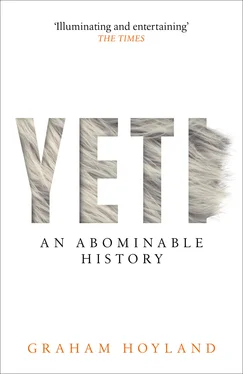Later, Tombazi and his companions descended to the spot and saw footprints ‘similar in shape to those of a man, but only six to seven inches long by four inches wide … The prints were undoubtedly those of a biped.’ 8Tombazi did not believe in the Abominable Snowman and thought what he had seen was a wandering pilgrim. One wonders why he bothered to report the sighting at all, but this suggests that thoughts of mysterious bipedal beasts were beginning to enter the minds of Himalayan explorers.
Undaunted by this conclusion, writers of books about Mount Everest, fuelled by George Mallory and Andrew Irvine’s mysterious disappearance near the summit in 1924, embroidered the tale even further. In 1937, Stanley Snaith produced a pot-boiler, At Grips with Everest, covering the five Everest expeditions to date, filled with speech-day guff about how Everest was ‘spiritually within our Empire’. He described how the Abominable Snowman’s footprints were made by ‘a naked foot: large, splayed, a mark where the toes had gripped the ground where the heel had rested.’ 9This is not what Howard-Bury reported, but from then on these tracks were made by a man-like monster.
The Case of the Abominable Snowman was a whodunit written in 1941 by one of our poets laureate, Cecil Day-Lewis, using the pen-name Nicholas Blake. Although not featuring the yeti but instead a corpse discovered inside a melting snowman, it indicated that the term had entered the public mind.
Our next book which exaggerated and distorted the Howard-Bury and Waddell reports was Abominable Snowmen by Ivan T. Sanderson. According to Sanderson, in 1920 (the wrong date) the Everest team led by Howard-Bury were under the Lhapka-La [ sic ] at 17,000 feet (the wrong altitude) watching ‘a number of dark forms moving about on a snowfield far above’. (They didn’t.) They hastened upwards and found footprints a size ‘three times those of normal humans’. (No!) Ivan T. Sanderson then states that the porters used the term yeti (and no, they didn’t).
Furthermore, Sanderson completely misrepresented Major Waddell’s report, making up details about bare feet making the footprints and completely omitting Waddell’s conclusion that they were made by a bear. Abominable Snowmen became the starting point for many subsequent yeti writers. But Sanderson listed both Howard-Bury’s and Waddell’s books in his bibliography and thus knew that neither of the expedition leaders believed their porters’ interpretation. But why spoil a good story?
If the first Western sightings of yeti prints were exaggerated and distorted, did this necessarily mean that all subsequent sightings were unreliable? As a BBC producer, I sometimes felt the temptation to embroider stories, but I can honestly say that in thirty years with the Corporation I saw little fakery. The temptation was always there, though.
Let me give an example. A good friend of mine was shooting a documentary series for an un-named TV company about a certain tribe in a certain country. It was horribly hot, and the director was loud, sweltering and increasingly angry that the local men he was filming on a hunting trip couldn’t even find and kill a rabbit. The budget was fast running out and he had a mortgage to pay. Aware, no doubt, that his next gig depended on a kill, he phoned a game park in a neighbouring country and ordered a small antelope to be shot and airlifted in. The resulting film shows a clip of grainy footage of a similar animal running away, and then cuts to a spear sticking out of the bullet hole in the corpse. The audience were shown this as a representation of truth and were deceived. The director got another job and his executive producer was satisfied. The problem is this: it was a lie.
As a rule, though, newspapers seem to be worse than TV, and the Internet is worse still. The rise of US President Donald Trump was accompanied by the rise of the so-called false news sites, where there are no editorial controls over content, and the only driver is the number of dollars racked up by click-bait.
I decided to check a few more of the famous yeti sightings and try to get to the bottom of them. Was the beast going to disappear before my eyes?

Our next account of the yeti, from 1937, is to be found in The Valley of the Flowers , 10by the English mountaineer, Frank Smythe. He was the first climber to make a living by writing books about his expeditions, unlike the Alpine Club set who were often independently wealthy. Smythe’s particular genius was the way in which he brought the wonder and pleasure of mountaineering to a wider public. However, in person he was famously grumpy, a condition which a companion wryly noted ‘decreased with altitude’. He initiated a furious volley of letters in The Times after his encounter with the yeti.
In The Valley of the Flowers , he wrote a chapter dedicated to the Abominable Snowman. This is worth quoting at length as it gives a flavour of Smythe’s writing style with his love of flowers, his gentle humour and his scientific approach to the subject of the yeti. It also contains all the classic ingredients of a yeti hunt: the exotic location, the find, the puzzlement and fear, the tracking and the deductions. His conclusions led to a public rebuttal, which would have consequences later.
Smythe was with a small party of Sherpas in an unexplored valley parallel to the Bhyundar valley, now in the state of Uttarakhand, northern India:
On July 16th I left the base camp, taking with me Wangdi, Pasang and Nurbu with light equipment and provisions for five days. The past week had seen many more flowers come into bloom, prominent among which was the pedicularis . This plant goes by the unpleasant popular name of lousewort, from the Latin pediculus , a louse, as one of the species, Pedicularis palustris , was said to infect sheep with a lousy disease; but it would be difficult to associate the beautiful pedicularis of the Bhyundar Valley with any disease, particularly the Pedicularis siphonantjia with its light purple blooms …
Next morning we were away in excellent weather. Being lightly laden, I was well ahead of the men. On approaching the pass, I was surprised to notice some tracks in the snow, which I first took to be those of a man, though we had seen no traces of shepherds. But when I came up to the tracks I saw the imprint of a huge naked foot, apparently of a biped, and in stride closely resembling my own tracks.
What was it? I was very interested, and at once proceeded to take some photographs. I was engaged in this work when the porters joined me. It was at once evident when they saw the tracks that they were frightened. Wangdi was the first to speak.
‘Bad Manshi!’ he said, and then ‘Mirka!’ And in case I still did not understand, ‘Kang Admi’ (Snowman).
I had already anticipated such a reply and to reassure him and the other two, for I had no wish for my expedition to end prematurely, I said it must be a bear or snow leopard. But Wangdi would have none of this and explained at length how the tracks could not possibly be those of a bear, snow leopard, wolf or any other animal. Had he not seen many such tracks in the past? It was the Snowman, and he looked uneasily about him …
Presently the men plucked up courage and assisted me. They were unanimous that the Snowman walked with his toes behind him and that the impressions at the heel were in reality the front toes. I was soon able to disprove this to my own satisfaction by discovering a place where the beast had jumped down from some rocks, making deep impressions where he had landed, and slithering a little in the snow …
Читать дальше












